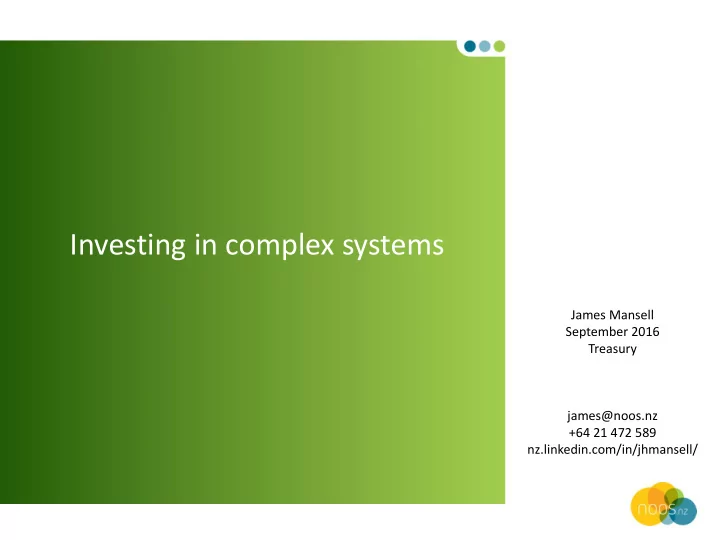

Investing in complex systems James Mansell September 2016 Treasury james@noos.nz +64 21 472 589 nz.linkedin.com/in/jhmansell/
Marc E Smith Age 20 AGE 1 2 3 4 5 6 7 8 9 10 11 12 13 14 15 16 17 18 19 Child Protection Abuse findings In care Education NCEA II tertiary Youth service Income Support IYB UB Corrections Prison Total cumulative 6 18 37 48 120 172 213k paid ($1000) YEAR 1991 1992 1993 1994 1995 1996 1997 1998 1999 2000 2001 2002 2003 2004 2005 2006 2007 2008 2009 2010 Note: Example is de- identified and chosen to reflect “average” high needs profile .
Operational use of shared data, predictive modelling and segmentation to understand class room performance 5 J Mansell, SDI Cross Jurisdictional Forum, 28 OCT 2014
Operational use of shared data, predictive modelling and segmentation to understand class room performance 6 J Mansell, SDI Cross Jurisdictional Forum, 28 OCT 2014
Investing in collective impact Shared systemic understanding, collective problem solving and impact
COLLECTIVE OWNERSHIP Build trust, relationships and shared collective decision making of those affected by and working within the system. A community of common ownership, dialogue and interests who codesign and are stewards of the system
• Canterbury initiative initiated with shared challenge; health pathways • Work in trusted way. Project bought people together. • Canterbury clinical network. • Build trust, facilitative role. • Assumptions; collective impact and adaptive leadership
SHARED ORIENTATION Shared measurable objective, direction and attribution. Mobilized towards common outcome and articulate your part in shared attribution to achieve those outcomes. Aim for global system maxima. Not local efficiency.
COLLECTIVE (RE)INVESTMENT Enabling local system design and reinvestment. Budget holding is for the population and the system and longer run, not individual service groups or reductionist.
CO-OWNED COORDINATION System level agility and coordination is obtained through shared communication about how to navigate the system. Helps turn globally good practice into localized practice. Agile because practice is based on information that can change
• 'This is how we do it around here'. • Co-designed by people inside system • Essentially Captured agreement • My part in pathway. • 2-way communication; “Send feedback” • Everyone always knows they are current. GitHub • High reliability organization; adaptive in crisis. Changed how system worked on back of earth quake. • Education Canterbury; help teachers understand get support for kids. • Australia, U.K.
SHARED INSIGHT AND LEARNING Feedback. Shared insight of the system provides real time feedback about how the parts of the system work together to produce a result. There is real time operational visibility of the system, analytical insight and an insight liaison service (interpretive and educational)
Managing the system of ED with high system visibility Ministry of Health 2016: Rate of people in ED by DHB, 2010/11 and 2014/15 (Canterbury lowest per capita and still declining)
Collective investment in longer term outcomes; Community falls prevention COMMUNITY FALLS PREVENTION • Agreed price (IDF) $815 per rehab bed day In the first four years, compared with expected (75+): • $8.714M costs foregone in last 12 months 1862 fewer ED attendances • 553 fewer fractured NOFs Cost of program: 6 Physios teaching people how to 32,008 fewer NOF bed days stand up - $650K pa 211 fewer deaths at 180 days Fewer admissions for # NOF Fewer bed days for # NOF
HIGH TRUST DATA INTEGRATION The backbone is ability to share and integrate deeply personal data. 90% will be non-government data and will be more reliable. This requires high trust and personal control . Needs to be inclusive to foster participation and innovation. People need to see value for themselves.
Mental Health and Addiction services • Challenge: Silos, capture of funding by specialists (Some DHBs good, others not), not working as a sytem. Disempowerment; Workforce lost ability to think they can make a difference – work the system rather than work on the system • Community forming: Platform Trust, Te Pou, Network 4 (PHOs with 2 million patients) • Collective impact principles, community development, • Place based approach; work on the objectives where there is community energy – suicide in one place, addiction in another. • Priorities: Rebuild trust, collaboration, rebuild relationships. Heavy lifting is done locally. • Collective investing
23 • CLASSIFIED IN CONFIDENCE – IR HIGHLY PROTECTED
Managing Change in a Complex Adaptive System Complex /chaotic systems cannot be managed in the sense of standing outside them and manipulating some of the elements towards a precise outcome . – Command and control is out. – Observation, negotiation and facilitation are the tools required.” “Complexity and Healthcare Organisation: A view from the Street” 2004, David Kernick Editor.
Recommend
More recommend